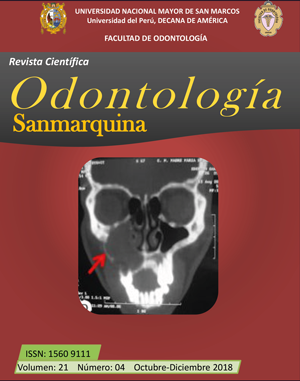Hydroxyapatite synthesized from the eggshell as a potential bone substitute in periodontal and peri-implant defects
DOI:
https://doi.org/10.15381/os.v21i4.15557Keywords:
Bone regeneration, Chemical precipitation, Egg shell, Hydroxyapatite, X-Ray diffractionAbstract
Synthetic hydroxyapatite is a biomaterial widely used in guided bone regeneration procedures. Objective: Synthesize synthetic hydroxyapatite from eggshells under different precipitates of nitric acid. Methods: Experimental study, which obtained CaCO3 from the pulverization of eggshells (Gallus gallus). The carbonate was titrated with three concentrations of nitric acid (5, 10 and 15%) and ammonium phosphate. The mixtures were tested at different calcination temperatures (150, 600, 700, 800 and 900 °C) and calcination times (2, 4, 8 and 12 h). X-ray diffraction analysis was used to characterize the presence of calcium carbonate and hydroxyapatite. Results: Of the different routes of synthesis, the route of precipitation of nitric acid by excess to 15% plus calcined calcium carbonate at 700 °C during 8h offered more equivalent results to the synthetic hydroxyapatite when compared with the commercial standard. The peaks of intensity corresponded to the angles 2θ: 20, 26, 33, 34, 40, 48 and 50. Conclusions: The method of synthesis by precipitation, using calcium carbonate from eggshells as substrate plus calcium nitrate and nitric acid; proved to be adequate and practical for the synthesis of hydroxyapatite. Its use can be replicated for toxicological characterization and response studies in pre-clinical experimental models.Downloads
Downloads
Published
Issue
Section
License
Copyright (c) 2018 Isabel Camacho Díaz, Melissa Vela Rodríguez, Ludolfo Villanueva Aburto, Andrés Borja Villanueva, Fred Montalvo Amanca, Justiniano Quispe Marcatoma

This work is licensed under a Creative Commons Attribution-NonCommercial-ShareAlike 4.0 International License.
AUTHORS RETAIN THEIR RIGHTS:
a. Authors retain their trade mark rights and patent, and also on any process or procedure described in the article.
b. Authors retain their right to share, copy, distribute, perform and publicly communicate their article (eg, to place their article in an institutional repository or publish it in a book), with an acknowledgment of its initial publication in the Odontología Sanmarquina.
c. Authors retain theirs right to make a subsequent publication of their work, to use the article or any part thereof (eg a compilation of his papers, lecture notes, thesis, or a book), always indicating the source of publication (the originator of the work, journal, volume, number and date).




















